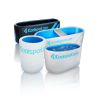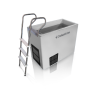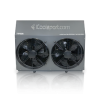Cold Plunge Terminology You Need to Know

There’s a lot of jargon you’re likely to encounter when researching ice baths. Here’s an explanation of some of these common terms so you can dive into the practice with confidence.
Inflammation
Inflammation is the process through which the immune system is activated in response to an irritant. This can take the form of chronic diseases like arthritis, or acute triggers such as exercise-induced muscle damage.
Cold exposure stems this process by lowering hypoxic stress and constricting blood vessels. The resulting reduction in swelling and muscle soreness has made ice baths a popular post-workout protocol for athletes in almost every sport.
Thermogenesis
Thermogenesis refers to the production of heat by biological sources. There are two main types: shivering and nonshivering thermogenesis.
Nonshivering begins when fat tissue is activated by the sympathetic nervous system. As the name suggests, shivering thermogenesis involves the actual contraction of skeletal muscle – a far more energy-intensive process.
A chilly ice bath induces both, along with a cascade of other beneficial biological effects.
The Soeberg Principle
Named after metabolic scientist and ice bath proponent Dr Susanna Søberg, this principle states that you should avoid immediately toweling off, getting dressed, or otherwise warming your body after cold immersion. Forcing your body to rewarm on its own significantly increases brown fat stimulation, and ultimately, calories spent.
If you’re interested in the fat-shedding properties of ice baths, be sure to read our Ice Baths for Weight Loss blog.
Vagus Nerve
The vagus nerve is the main driver of your parasympathetic nervous system. It’s responsible for the regulation of internal organ functions including digestion, heart rate, and respiratory rate, as well as vasomotor activity and certain reflex actions (e.g. coughing and sneezing).
Cold plunges prompt the vagus nerve to decrease the heart rate, and in doing so, signal your body to destress, relax, and build mental resilience.
Box Breathing
Box breathing is a popular method of maintaining your cool when presented with a stressful situation or environment. You can perform this breathing technique anywhere and at any time, just follow the simple steps below.
Inhale for four seconds.
Hold your breath for four seconds.
Exhale for four seconds.
Hold your breath for four seconds.
Repeat steps 1 – 4 as needed.
Try this method the next time you’re struggling to conquer a particularly cold ice bath. You’ll be surprised with just how effective it can be.
Dopamine
Dopamine is a neurotransmitter and hormone that plays an important role in pleasure, motivation, movement, and learning. While most often associated with intense feelings of reward, low levels have been linked to Parkinson’s disease, tiredness, and depression.
Researchers in the Czech Republic have found that cold water immersion can increase blood concentrations of dopamine by up to 250%. This likely explains the mood boost and improved mental acuity that many report after taking ice baths.
Curious About Ice Baths?
Whether you’re an ice bath veteran or just dipping your toes into the practice, iCoolsport is home to all the know-how and products you need.
iCool invented modern ice baths and we are the largest global supplier. From the single-person IceOne bath to solutions big enough for teams, we cover all bases.
Our iCool Compact Chill chiller is suitable for baths of up to 500L and can maintain a constant water temperature of as little as five degrees. With easy to use one touch start and wifi remote controls, it takes the hassle out of regular ice baths and allows you to increase your cold tolerance gradually and consistently.
For more information about ice baths peruse our blog and explore our range online.















